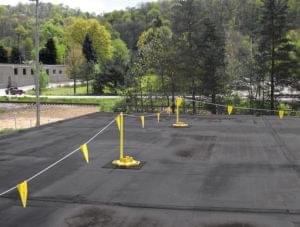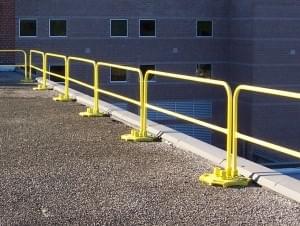OK, so you need to get workers out on your roof. Maybe it’s to work on or inspect the HVAC system. Maybe it’s to clear snow or weather-related debris. Or maybe it’s to do roofing work, skylight work, or general maintenance. Whatever your reason, if you have workers on your roof, they’re going to be exposed to fall hazards—which means you’ll need a fall protection system in place.
Perhaps your roof work is infrequent—and for that reason, a warning line system seems more appealing than installing a roof guard rail. But unfortunately, this minimal approach might not meet OSHA requirements. What’s best for your needs? Let’s begin with the basics:
The differences between a roof guard rail and a warning line system seem obvious. One serves only as visual warning, akin to someone saying “watch your step,” while the other can actually prevent a fall from ever happening. But let’s take a closer look nonetheless:
 Warning Lines:
Warning Lines:These are lines that run around a roof or work area to warn employees that they are approaching an unprotected edge. They are also used to identify roof areas where work may be conducted without guardrails, harnesses, or safety nets (see Designated Areas below).
OSHA warning lines may be made of rope, wire, or chain, and they must have a minimum tensile strength of 500 pounds. They also must be flagged or marked at 6-foot intervals (or less) with a high-visibility material. They also must be set up in such a way that they are no lower than 34 inches and no higher than 39 inches from the roof surface. Though cost-effective, they are usually only appropriate for specific projects and designated areas.

This fall protection system is actually a barrier that prevents workers from falling from a roof edge or to a lower level when working at height. It consists of uprights, top rails, mid rails, and sometimes screening or mesh between the top rail and the working surface. If there is a risk of tools or materials falling on workers below, a toe board must also be included.
A roof guard rail can be either a portable or a permanent fixture to your roof, depending on the brand you choose. At BlueWater, we manufacture guard rails that are non-penetrating, so they serve as both portable and permanent. While a roof guard rail system may be a bigger expense upfront, if there is going to be regular, frequent work at height, it is one worth making—and can ultimately be more cost-effective than purchasing harnesses, lanyards, lifelines, and other equipment you may need in conjunction with a warning line (which will also require regular employee training, inspection, and replacements to boot).
You already know that you have an obligation to provide fall protection to your employees (and anyone else that might find themselves in harm’s way). OSHA regulations state that work that takes place on a rooftop 4 feet or more above the ground or a lower level requires a conventional protection system for general industry (6 feet for construction), such as a roof guard rail, a personal fall arrest system, or a safety net. There are very limited situations where a warning line system could be deemed appropriate—and they’re considered a last resort. In other words, they are only deemed appropriate if it’s proven that a guardrail and/or harness and lanyard aren’t possible for the scope of the job.
To paraphrase OSHA:
“OSHA's fall protection standard for construction, 29 CFR 1926 Subpart M (beginning at §1926.500), generally requires fall protection when there is a fall distance of 6 feet or more. In a few, very specific situations, because of feasibility limitations, the standard permits the use of a warning line, in combination with other measures, instead of conventional fall protection (guardrail systems, personal fall arrest systems or safety net systems) to keep employees away from an edge.”
But keep in mind, OSHA goes on to say that it is possible to implement a site-specific fall protection plan that uses alternative fall protection only if the infeasibility of conventional fall protection can be demonstrated. (You can read about it in depth here.)
What’s more, to be compliant, OSHA warning lines need to adhere to the following.
What does that all mean? The purpose of a warning line system is to alert employees of an unprotected edge only. It can’t prevent a slip or trip that leads someone over the edge. There are only a few situations where the standard allows the use of a warning line in lieu of a standard fall protection system, and it’s only feasibility of fall protection is determined to be limited. If you haven’t already noticed, the uses of warning lines are so specific, trying to figure out if it’s both appropriate and compliant to your project can be pretty confusing. It’s a good rule of thumb to be protected, and that usually means having guardrails installed where you need them to be. To best determine what your needs are, we recommend you speak directly with OSHA or with a trusted safety manufacturer.
According to OSHA, a designated area is a distinct portion of the walking-working surface, delineated by a warning line, in which workers may perform work without additional fall protection. But, keep in mind, a warning line will not stop a fall, so it is advised to still employ guardrails along the perimeter.
Choosing the right fall protection system may seem difficult, but it’s actually quite simple. Often, your best bet is to take the guesswork out of the equation with the installation of a roof guard rail. If this type of fall protection system is unfeasible for your company, perhaps a warning line system and/or use of harnesses and lanyards are your best bet. If you are having trouble determining which is best for you, give us a call. We make it our business to make sure yours is running smoothly and safely—so you can focus on getting the job done.